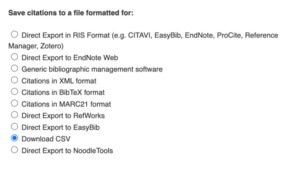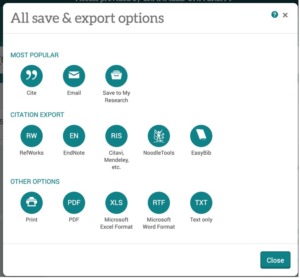Systematic Literature Review – Managing duplicates
11/07/2024

One of the questions which often comes up when discussing the SLR process is how do I manage my references in the most efficient way during the process of going from my search results to my final list of articles?
Each step of the SLR process has its own challenges. You need to identify your keywords, then construct your search strings, then work out the combinations of the search strings and which databases to use e.g., EBSCO Business Source Complete, ProQuest One Business, Scopus, Web of Science, in order to retrieve the articles which are key to your research topic.
Not all the articles retrieved will be relevant and you will need to filter your initial results sets according to the inclusion and exclusion criteria you defined in your protocol. You will begin by screening the title and abstract against your inclusion and exclusion criteria, and then against the full text. At each stage you will need to document:
- how many articles there were
- for each of your search string combinations
- from each of your chosen databases.
Sounds simple enough, until you realise that there will inevitably be duplication between the sources…
The good news is that you can export all of your references, with abstracts, directly from each of these resources. The download option to use for EBSCO Business Source Complete and Scopus is the CSV option. For ProQuest One Business it is XLS and for Web of Science it is Excel.
EBSCO Business Source Complete
Add your search results to a folder. Then go to your folder, select all the articles and use the Export function to export your results to a CSV file. Once exported, save your results as an Excel file.

ProQuest One Business
You can add your search results to a folder in ‘My research’ or export your results to Excel direct from the search results page. To do this, click on the three dots (ellipsis) to open the ‘All save & export options’ and select the XLS Microsoft Excel Format. Note you can export up to 100 articles at a time.

Scopus and Web of Science
You can export your results direct from the results page of both of these indexes by selecting the Export option and following the instructions given.
Once you have downloaded the information into Excel, you can then use the power of Excel to help you tag, filter and sort your references so that you can easily identify duplicates and also keep track of which references were found in each database.
ExcelDemy provides further guidance on how to use Excel to remove duplicates, which you may find useful.
Other blog posts you may find useful:
- Systematic Literature Review – Where do I begin?
- Systematic Literature Review – Selecting your Sources
- Systematic Literature Review – Identifying your search terms and constructing your search strings
- Systematic Literature Review – Combining your search strings to create your search strategy
Because of the complexity of this process, we recommend that before embarking on a systematic literature review you speak with your Librarian who will be happy to provide guidance.
Image by kirill_makes_pics from Pixabay
Categories & Tags:
Leave a comment on this post:
You might also like…
Creating and using constituent lists in Datastream
Whether you're analysing industry performance, or comparing company financials, Datastream is a powerful tool. One of its most useful features is the ability to work with constituent lists — collections of companies grouped by index, ...
Landing at Cranfield: First-term experiences and life beyond the classroom
Starting a postgraduate course can feel daunting, especially if you’re new to the aviation industry. In this blog series, Adit Shah shares his journey on the Air Transport Management MSc at Cranfield. From first-term ...
Accelerating ambition: How Amelie Rohan engineered her future at Cranfield
In the world of high-performance automotive engineering, the gap between being a “fan” and being a professional is measured in more than just miles. It is measured in technical precision, hands-on ...
Study better and smarter in 2026
Happy new year! Now is the perfect time to reflect on your studies so far, thinking about what you’re doing well and where you need to focus a bit more attention. Getting back into ‘study ...
Cleared for the future: Why aviation leaders must embrace environmental sustainability
Environmental sustainability is not a niche concern for aviation anymore, it’s central to how we think about the future of our industry. In my work as an Associate Professor of Airport Decarbonisation, I see first-hand ...
Preparing your work for Turnitin submission
Before submitting your work into Turnitin for similarity checking, if you have used referencing software then you may need to take some important steps first. Mendeley and Zotero integrate with MS Word by embedding field ...






